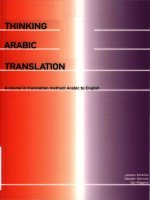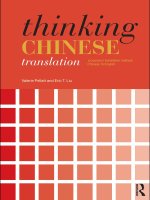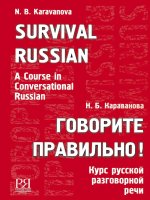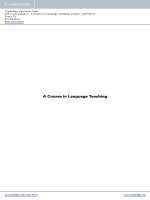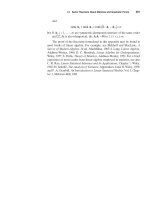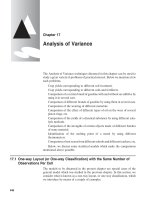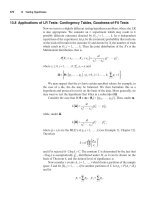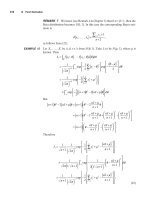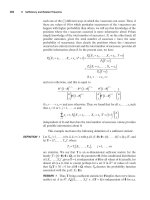A course in language teaching practice and theory ur penny
Bạn đang xem bản rút gọn của tài liệu. Xem và tải ngay bản đầy đủ của tài liệu tại đây (38.18 MB, 390 trang )
CAMBRIDGE
UNIVERSITY
PRES S
Cambridge,
New York,Melbourne,Madrid, CapeTown,Singapore,
Sio Paulo,Delhi
CambridgeUniversityPress
The EdinburghBuilding,CambridgeCB2 8RU,UK
www.cambridge.org
Information on this title: www.cambridge.org19780521,449946
@ CambridgeUniversity
Press1991
It is normallynecessary
for writtenpermissionfor copyingto be
obtainedin aduancefrom a publisher.The worksheets,role play
card,testsandtapescripts
at the backof this book aredesigned
to
be copiedand distributedin class.The normal requirements
are
waivedhereand it is not necessaryto write to CambridgeUniversity
Pressfor permissionfor an individual teacherto make copiesfor use
within his or her own classroom.Only thosepageswhich carry the
wording 'O CambridgeUniversityPress'may be copied.
Firstpublished1996
lTth printing2009
Printedin the United Kingdomat rhe UniversiryPress,Cambridge
A cataloguerecordfor this publicationis auailablefrom the British Library
Library of CongressCataloguingin Publicationdata
Ur, Penny.
A coursein languageteaching:practiceand theory / PennyUr.
p. cm.
Includesbibliographical
refrrences.
ISBN978-0-521
-44994-6paperback
1. Languageand language- Studyand teaching.I. Title
P51.U71995
41.8'.007- dc20
94-35027
CIP
ISBN 978-0-521-44994-6
Paperback
CambridgeUniversityPresshas no responsibilityfor the persistence
or
accuracyof URLs for externalor third-party Internetwebsitesreferredto in
this publication,and doesnot guaranteethat any contenton suchwebsitesis,
or will remain,accurateor appropriate.Information regardingprices,travel
timetablesand other factual information givenin this work are correctat
the time of first printing but CambridgeUoiversityPressdoesnot guaranree
the accuracyof suchinformation thereafter.
Gontents
Units with a ) symbol are componentsof the 'core' course;thosewith a F
symbolare'optional'.
Acknowledgements
ix
Readthisfirst To the (trainee)teacher
To thetrainer
xii
xl
lntroduction
Module
1:Presentations
andexplanations
) Unit One: Effectivepresentation
D Unit Two: Examplesof presentationprocedures
) Unit Three: Explanationsand instructions
LI
1.3
L6
2:Practice
Module
activities
)
)
)
D
Unit
Unit
Unit
Unit
One:
Two:
Three:
Four:
The function of practice
Characteristicsof a good practiceactiviry
Practicetechniques
Sequenceand progressionin practice
Module
3:Tests
'What
)
)
)
F
F
Unit
Unit
Unit
Unit
Unit
One:
Two:
Three:
Four:
Five:
are testsfor?
Basicconcepts;the test experience
Typ"r of test elicitation techniques
Designinga test
Testadministration
19
21,
24
27
11
JJ
35
37
41,
42
4:Teaching
Pronunciation
Module
)
F
)
F
)
,
Unit
Unit
Unit
Unit
Unit
One:
Two:
Three:
Four:
Five:
'What
doeste4chingpronunciation involve?
Listeningto accents
Improving learners'pronunciation
Further topics for discussion
Pronunciationand spelling
47
50
52
54
56
Contents
Mo d u 5
l e:T e a ch ivo
n gca bular y
)
)
tr
)
F
Unit
Unit
Unit
Unit
Unit
One:
Two:
Three:
Four:
Five:
\fhat is vocabulary and what needsto be taught?
Presentingnew vocabulary
Rememberingvocabulary
Ideasfor vocabularywork in the classroom
Testingvocabulary
60
63
64
68
69
Mo d u 6
l e:T e a ch ignra
g mm ar
)
F
tr
)
)
D
Unit
Unit
Unit
Unit
Unit
Unit
One:
Two:
Three:
Four:
Five:
Six:
'Vfhat
is grammar?
The place of grammar teaching
Grammaticalterms
Presentingand explaining grammar
Grammar practiceactivities
Grammaticalmistakes
75
76
78
81
83
85
Module
7:Topics,
situations,
notions,
functions
)
)
)
F
F
Unit
Unit
Unit
Unit
Unit
One:
Two:
Three:
Four:
Five:
Topics and situations
What ARE notions and functions?
Teachingchunks of language:from rext to task
Teachingchunks of language:from task to text
Combining different kinds of languagesegments
90
92
93
96
98
Module
8:Teaching
listening
)
)
tr
)
F
Unit
Unit
Unit
Unit
Unit
One:
Two:
Three:
Four:
Five:
\7hat doesreal-life listeninginvolve?
Real-lifelisteningin the classroom
Learnerproblems
Typesof activities
Adapting activities
105
1,07
1.1,1,
1,1,2
115
Mo d u 9
l e:T e a ch isp
n ge a king
)
)
)
F
F
D
Unit One:
Unit Two:
Unit Three:
Unit Four:
Unit Five:
Unit Six:
Successfuloral fluencypracice
The functions of topic and task
Discussionactivities
Other kinds of spokeninteracrion
Role play and relatedtechniques
Oral testing
120
1.22
1,24
1,29
131.
133
Mo d u l1e0T: e a ch ire
n ga ding
)
F
)
)
F
VI
Unit
Unit
Unit
Unit
Unit
One:
Two:
Three:
Four:
Five:
How do we read?
Beginningreading
Typesof readingactivities
Improving readingskills
Advancedreading
138
1,41
143
147
150
Contents
Module
11:Teaching
writing
F
)
)
D
)
Unit
Unit
Unit
Unit
Unit
One:
Two:
Three:
Four:
Five:
Written versus spoken text
Teachingprocedures
Tasks that stimulate writing
The processof composition
Giving feedback on writing
t59
r62
r64
1.67
170
M o d u l1e2 :T hsyl
e labus
'Sfhat
is a syllabus?
) Unit One:
) Unit Two: Different fypes of language syllabus
) Unit Three: Using the syllabus
176
777
179
M o d u l1e3 :Ma te ri a l s
)
)
)
F
F
Unit
Unit
Unit
Unit
Unit
One:
Two:
Three:
Four:
Five:
How necessaryis a coursebook?
Coursebookassessment
Using a coursebook
Supplementarymaterials
Teacher-made
worksheetsand workcards
183
1,84
1,87
1,89
192
Module
14:Topic
content
)
)
tr
)
D
Unit
Unit
Unit
Unit
Unit
One:
Two:
Three:
Four:
Five:
Different kinds of content
Underlying messages
Literature (1): should it be included in the course?
Literature (2): teachingideas
Literature (3): teachinga specifictext
197
199
200
202
206
M o d u l1e5L: e ssopnl a n n i n g
)
D
)
F
)
Unit
Unit
Unit
Unit
Unit
One:
Two:
Three:
Four:
Five:
What doesa lessoninvolve?
Lessonpreparation
Varying lessoncomponents
Evaluatinglessoneffectiveness
Practicallessonmanagement
2t3
2t5
216
2L9
222
16:Classroom
interaction
Module
)
)
)
)
D
Unit
Unit
Unit
Unit
Unit
One:
TWo:
Three:
Four:
Five:
Patternsof classroominteraction
Questioning
Group work
Individualization
The selection of appropriate activation techniques
227
229
232
233
237
M o d u l1e7Gi
: vi nfe
g e d b a ck
)Unit One:
Different approachesto the nature and function of
feedback
242
vll
Contents
D
)
)
D
Unit
Unit
Unit
Unit
Two:
Three:
Four:
Five:
Assessment
Correctingmistakesin oral work
lTritten feedback
Clarifying personalattitudes
244
246
250
253
: l a ssrodoim
Mo d u l1e8C
scipline
) Unit One: What is discipline?
) Unit Two: What doesa disciplinedclassroomlook like?
D Unit Three: What teacheraction is conduciveto a disciplined
classroom?
) Unit Four: Dealing with disciplineproblems
F Unit Five: Discipline problems:episodes
2s9
260
262
264
267
motivation
Module
19:Learner
andinterest
D
F
)
)
F
Unit
Unit
Unit
Unit
Unit
One:
Two:
Three:
Four:
Five:
Motivation: somebackgroundthinking
The teacher'sresponsibility
Extrinsic motivation
Intrinsic motivation and interest
Fluctuationsin learnerinterest
Module
20:Younger
andolder
learners
'What
)
D
D
D
Unit
Unit
Unit
Unit
One:
differencedoesagemake to languagelearning?
Two: Teachingchildren
Three: Teachingadolescents:studentpreferences
Four: Teachingadults: a different relationship
274
276
277
280
282
286
288
290
294
Module
21:Large
heterogeneous
classes
)
)
)
)
D
Unit
Unit
Unit
Unit
Unit
One:
Two:
Three:
Four:
Five:
Defining terms
Problemsand advantages
Teachingstrategies(L): compulsory + optional
Teachingstrategies(2): open-ending
Designingyour own activities
302
303
307
309
3L2
Module
22:Andbeyond
F
F
tr
F
vlll
Unit
Unit
Unit
Unit
One:
Two:
Three:
Four:
Teacherdevelopment:practice,reflection,sharing
Teacherappraisal
Advancing further (1): intake
Advancing further (2): output
318
322
324
327
Bibliography
360
In d e x
367
Acknowledgements
I should like to thank all those who have contributed in different ways to this
book:
- To editor Marion'STilliams, who criticised, suggestedand generally
supported me throughout the writing process;
- To Cambridge University Press editors Elizabeth Serocold and Alison Sharpe,
who kept in touch and often contributed helpful criticism;
- To Catherine Walter, who read the typescript at a late stage and made
practical and very useful suggestions for change;
- To my teachers at Oranim, with whom I have over the years developed the
teacher-training methodology on which this book is based;
- And last but not least to my students, the teacher-trainees, in past and present
pre-service and in-service courses, to whom much of this material must be
familiar. To you, above anyone else, this book is dedicated; with the heartfelt
wish that you may find the fulfilment and excitement in teaching that I have;
that you may succeed in your chosen careers, and may continue teaching and
learning all your lives.
The authors and publishersare grateful to the authors,publishersand otherswho have
given their permission for the use of copyright information identified in the text. \7hile
everyendeavourhas beenmade,it has not beenpossibleto identify the sourcesof all
material usedand in suchcasesthe publisherswould welcomeinformation from
copyright sources.
p6 diagram from ExperentialLearning: Experienceas the Sourceof Learning and
Deuelopmenrby David Kolb, published by PrenticeHall, 1984@ David Kolb; p14 from
'Exploiting textbook dialoguesdynamically' by Zokan Drirnyei, PracticalEnglisb
Teacbing,1986,614:1.5-16,and from 'Excuses,excuses'by Alison Coulavin, Practical
English Teaching,1983,412:31@ Mary Glasgow MagazinesLtd, London; p14 from
English Teacher'sJournal, 1986,33; p48 from Pronunciation Tasksby Martin
Hewings, Cambridge University Press,1993;p77 (extracts1 and 2) from 'How nor to
interferewith languagelearning' by L. Newmark and (extract3) from 'Directions in the
teachingof discourse'by H. G. Widdowson in The CommunicatiueApproach to
LanguageLearning bV C.J. Brumfit and K. Johnson (eds.),Oxford University Press,
1979,by permissionof Oxford Univer3ityPress;p77 (extract4) from Awarenessof
Language:An Introdwction by Eric Hawkins, Cambridge University Press,1984;p116
adapted from TeachingListening Comprehensionby PennyUr, Cambridge University
Press,1984;p130 (extract 1) from The LanguageTeachingMatrix by Jack C. Richards,
Cambridge University Press,1990;p1.30(extract2) from Teachingtbe SpokenLanguage
by Gillian Brown and GeorgeYule, Cambridge University Press,1983;p130 (extract3)
from Discussionsthat Work-by PennyUr, Cambridge University Press,1981;pp 130-1
from Ro/e Play by G. Porter-Ladousse,Oxford University Press,1987,by permissionof
Oxford Univsrsity Press,pl51 from Task Reading by EvelyneDavies,Norman
Whitney, Meredith Pike-Blakeyand Laurie Bass,CarnbridgeUniversity Press,1.990,p152
from Points of Departure by Amos Paran,Eric Cohen Books, 1.993;p153 from Effectiue
Reading: Skillsfor AduancedStudentsby Simon Greenall and Michael Swan, Cambridge
IX
Acknowledgements
University Press,1985; Beat the Burglar, Metropolitan Police; p157 (set 3) from A few
short hops to Paradise'by JamesHenderson, The Independenton Sunday,l'1'.12'94,by
permission of The Independent; p160 from Teaching.Written English by Ronald V
'White,Heinemann Educational Books, 1980,by permissionof R. .White;p207'Teevee'
from Catch a little Rhyme by Eve Merriam @ 1966 Eve Merriam. @ renewed 1994 Dee
Michel and Guy Michel. Reprinted by permission of Marian Reiner; p251 from English
Grammar in[Jseby Raymond Murphy, Cambridge University Press,1985;p269 (episode
1 and 3) from ClassManagementand Controlby E. C. Wragg,Macmillan, 1981,
(episode2 and 5) adapted from researchby Sarah Reinhorn-Lurie;p281 (episode4) and
p291 from Classroom Teacbing Skillsby E. C. Wragg, Croom Helm, L984; p323 based
on Classroom Obseruation Tasks by Ruth !(ajnryb, Cambridge University Press,t992.
Drawings by Tony Dover. Artwork by Peter Ducker.
Rea
dthisfirst
This book is a coursein foreign languageteaching,addressedmainly to the
trainee or novice teacher,but some of its material may also be found interesting
by experiencedpractitioners.
If it is your coursebookin a trainer-ledprogramme of study then your trainer
will tell you how to use it. If, however, you are using it on your own for
independent study, I suggestyou glance through the following guidelines before
starting to read.
How to use the book
1. Skim through, get to know the'shape'of the book
Beforestarting any systematicstudy,have a look at the topics as laid out in the
Contents,leaf through the book looking at headings,read one or two of the
tasksor boxes.
The chaptersare called'modules' becauseeachcan be usedindependently;
you do not have to have done an earlier one in order to approach alatet On the
whole, however,they are ordered systematically,with the more basictopics
first.
2. Do not try to read it all!
This book is rather long, treating many topics fairly fully and densely.It is not
intendedto be read cover-to-cover.Someof the units in eachmodule are 'core'
units, marked with a black arrowhead in the margin next to the heading;you
should find that thesegive you adequatebasiccoverageof the topic, and you
can skip the rest. However,glanceat the 'optional' units, and if you find
anything that interestsyou, use it.
3. Using the tasks
The tasks are headedTask, Question,lnquiry, etc., and are printed in bold.
They often refer you to material provided within a rectangular frame labelled
Boxz for example in Module 1, Unit One there is a task in which you are asked
to considera seriesof classroomscenariosin Box 1.1, and discusshow the
teacherpresentsnew material in each.
The objectiveof the tasks is to help you understandthe material and study it
thoughtfully and critically - but they are rather time-consuming.Those that are
clearly meant to be done by a group of teachersworking togetherare obviously
impractical if you are working alone, but othersyou may find quite feasibleand
rewarding to do on your own. Someyou may prefer simply to read through
xl
Readthis first
without trying themyourself.In any case,possiblesolutionsor comments
usuallyfollow immediatelyafter the task itself, or areprovidedin the Notes
sectionat the endof eachmodule.
If vou areinterestedin moredetailedrntormatronabout the materialin this
book and the theory behindit, go on to reaclthe lntroductron on Pages1-9.
To the trainer
This book presentsa systematicprogrammeof studyintendedprimarily for preserviceor noviceteachersof foreignlanguages.
Structure
whichI havecalled'modules',sincetheyare
It is composedof.22chapters
Eachmoduleis dividedinto unitsof study;a unit
intendedto befree-standing.
usuallytakesbetweenoneandtwo hoursto do.
A foundationcourseis providedby the coreunits (labelledwith black
arrowheadsin the marginwheretheyoccurin the book,and in the Contents);
sucha coursewould takeabout50-80 hoursof classtime if you do not
it in anyway.Someof the optionalunitsmay be substitutedfor core
supplement
units whereyou feelit appropriatefor your own context,or simply addedfor
further enrichment.An evenshortercoufsemay be basedon the coreunits of
onlv the first elevenmodules.
courses;a Isingle
for short
snort rn-servrce
rn-servrce
modulesmay
mavbeusedas basestor
Individual
lndrvrdualmodules
module,studiedin its entireryshouldtakeaboutonestudyday (aboutsix
tl
nours,to get tnrougn.
Content
The materialin the modulesincludesinformation, tasksand study basedon
practiceteachingand observation.
The information sectionscan furnish eithera basisfor your own input
checkson
sessions
or readingfor trainees.Thereareoftenbrieftasks(questions,
which may be usedfor shon
within thesesections,
interspersed
understanding)
or homewriting assignments.
discussions
to materiallaid out in the boxes:for
Tasksareusuallybasedon responses
examplea box may displaya shortscenarioof classroominteraction,and the
readeraskedto criticizethe way the teacheris elicitingstudentresponses.
'Where
appropriate,possiblesolutionsor my own ideason the issuesaregiven
immediatelybelowthe task.This closejuxtapositionof questionsand answers
is intendedto savethe readerfrom leafingback and forth looking for the
is that traineesmay be temptedto look
but the disadvantage
answerselsewhere,
first. The
on to the answerswithout engagingproperlywith the task themselves
of fne
the
probablyto maKe
makecopresor
problemls proDably
practicalsolutron
this problem
s olutionto thls
most practlcal
relevantbox (which should be marked@CambridgeUniversityPress)and hand
instructionsyourself,so that trainees
them out separatelygiving any necessary
xll
Readthis first
do not needto open the book at all in order to do the task; they may later be
referredto the possiblesolutionsin the book for comparisonor further
discussion.
How much you usethe tasksinvolving teachingpracticeand observation
depends,of course,on whether your traineesare actually teachingor have easy
and the viewing of
accessto activelanguage-learningclasses.Peer-teaching
video recordingsof lessons(for example,Looking at LanguageClassrooms
(t996) CambridgeUniversity Press)may be substitutedif necessary.
The Trainer'snotesat the end of the book add somesuggestionsfor
variations on the presentationof the different units, and occasionallycomment
on the background,objectivesand possibleresultsof certain tasks.They also
include estimatesof the timing of the units, basedon my experiencewhen doing
them with my own traineeslhowever,this is, of course,only a very rough
approximation, and variesa greatdeal, mainly dependingon the needfelt by
you and the traineesto developor cut down on discussions.
The following Introduction providesmore detailson the content and layout
of the book and its underlying theory and educationalapproach.
xlll
lntroduction
Gontent
The main part of this book is divided into 22 modules,eachdevotedto an
aspectof languageteaching(for example'grammar', or 'the syllabus').At the
end of most modulesis a set of Notes, giving further information or comments
on the tasks.Also attachedto eachmodule is a sectionentitled Further reading,
which is a selectedand annotatedbibliography of books and articlesrelevantto
the topic.
The modulesare grouped into sevenparts, eachfocussingon a cerftralaspect
or themeof foreign languageteaching:Part I, for example,is calledThe
teacbingprocess)and its modulesdeal with the topics of presentation,practice
and testing.Eachpart has a short introduction definingits theme and clarifying
the underlying concepts.
Each module is composedof severalseparateunits: theseagain are freestanding,and may be usedindependentlyof one another.Their content
includes:
l.lnput: background information, both practical and theoretical.Suchinput is
intendedto be treatednot as somekind of objective'truth' to be accepted
and learnedas it stands,but as a summary of ideasthat professionals,
scholarsand researchershave produced and which teachersthereforemay
benefitfrom studying and discussing.Thesesectionsmay simply be read by
teachersindependentlgor mediatedby trainers through lecturesessions.
Input sectionsare usually precededor followed by questionsor tasksthat
allow readersto reflecton and interact with the ideas,checkunderstanding
or discusscritically; in a trainer-ledsessionthey can serveas the basisfor
brief group discussionsor written assignments.The point of this is to ensure
that traineesprocessthe input and make their own senseof it rather than
simply acceptinga body of transmittedinformation.
2. Experiential work: tasks basedon teaching/learningexperience,which may
be one or more of the following:
a) Lessonobservation:focussingon the point under study.
b)Classroom teaching:where the teachertries out different procedureswith
classesof foreign languagelearners.
c) Micro-teaching:the teacherteachessmall groups of learnersor an
individual learnerfor a short period in order to focus on a particular
teachingpoint.
d) Peer-teaching:
one of a group of teacherstries out a procedureby
'teaching'the rest of the group.
lntroduction
e) Experiment: teacherstry out a techniqueor processof learning or
teaching,document resultsand draw conclusions.
f) Inquiry: a limited aspectof classroomteachingis studied through
observation,practice, or limited survey;the resultsof the study may be
written up and made availableto others.
Most experientialwork is followed by critical reflection,usually in the
form of discussionand/or writing. Its aim is to allow teachersto processnew
ideasthoughtfully and to form or test theories.
For teacherswho are not in a position to try out experientialprocedures
themselves,somepossibleresultsand conclusionsare given within the unit
itself or in the Notes at the end of the module.
3. Tasks:learning tasks done by teachersin groups or individually, with or
without a trainer, through discussionor writing. Thesemay involve such
processesas critical analysisof teachingmaterials,comparison of different
techniques,problem-solvingor free debateon controversialissues;their aim
is to provoke careful thinking about the issuesand the formulation of
personaltheories.Brief tasks may be labelled Question, Application or To
checkunderstanding,and usually follow or precedeinformational sections.
As with the experientialtasks,suggestedsolutions,resultsor commentsare
suppliedwhere appropriate: immediately following the task if they are seenas
useful input in themselves;or in the Notes at the end of the module if they are
seenrather as optional, perhapsinteresting,additions (my own personal
experiences,for example,or further illustration).
Different componentsare often combined within a unit: a task may be basedon
a reading text, or on teachingexperience;an idea resulting from input may be
tried out in class.This integration of different learning modesprovides an
expressionin practice of the theory of professionallearning on which this book
is based,and which is discussedin the Rationale below.
Note that although this courseis meant for teachersof any foreign language,
examplesof texts and tasks are given throughout in English (exceptwhen
another languageis neededfor contrast). The main reasonfor this is that the
book itself is in English, and I felt it was important as a courtesyto the reader to
ensurethat all illustrative material be readily comprehensible.Also, of course,
English itself is probably the most widely taught languagein the world today;
but if you are concernedwith the teachingof another language,you may need
to translateor otherwiseadapt texts and tasks.
The collection of topics on which the modules are basedis necessarily
selective:it is basedon those that furnish the basisfor my own (pre-service)
teacher-trainingprogramme, and which seemto me the most important and
useful.The last module of the book includesrecommendationsfor further
studS with suggestedreading.
lntroduction
Rationale
Defining concepts
'Training' and'education'
The terms 'teachertraining' and 'teachereducation' are often usedapparently
interchangeablyin the literature to refer to the samething: the professional
preparation of teachers.Many prefer 'teachereducation', since'training' can
imply unthinking habit formation and an over-emphasison skills and
techniques,while the professionalteacherneedsto developtheories,awareness
of options, and decision-makingabilities- a processwhich seemsbetter defined
by the word 'education' (see,for example,Richardsand Nunan,l'9901. Others
have made a different distinction: that 'education' is a processof learning that
developsmoral, cultural, social and intellectualaspectsof the whole personas
an individual and member of society,whereas'training' (though it may entail
some'educational'components)has a specificgoal: it preparesfor a particular
function or profession(Peters,1,9662Ch.I). Thus we normally refer to 'an
educatedperson', but'a trained scientist/engineer/nurse'.
The secondof the two distinctionsdescribedabove seemsto me the more
useful:this book thereforeusesthe term 'training'throughout to describethe
processof preparation for professionalteaching,including all aspectsof teacher
development,and reserves'education' for the more varied and generallearning
that leadsto the developmentof all aspectsof the individual as a memberof
society.
Practice and theory
Teacherscommonly complain about their training: 'My coursewas too
theoretical,it didn't help me learn to teach at all'; or praisea trainer: 'Sheis so
practical!' Or they say: 'It's fine in theory, but doesn'twork in practice.'It
soundsas if they are sayingthat theory is uselessand practiceis what they
want. And indeedthis is what many teachersfeel.But they are understanding
the two words in a very specificway: 'theory' as abstract generalizationthat has
no obvious connection with teaching reality; 'practice' as tips about classroom
procedure. The two conceptsare understood rather differently in this book.
Practiceis definedhere as (a descriptionof) a real-time localizedevent or set
of such events:particular professionalexperiences.Theory is a hypothesisor
classes
conceptthat generalizes;it may cover a set of practices('heterogeneous
learn better from open-endedtasksthan from closed-endedones');or it can
describephenomenain generalterms ('languageis usedfor communication'); or
it can expressa personalbelief ('languagelearning is of intrinsic value'). (For a
more detaileddiscussionof different types of theory seeStern, 1'983:23-32.)
Experiencing or hearing about practice is of limited use to the teacher if it is not
made more widely applicableby being incorporatedinto somesort of
theoretical framework constructed and 'owned' by the individual. For example,
you might learn about a brainstorming activity ('How many things can you
think of that ... ?') which can be usedat certain levelsfor practisingcertain
language;but if that is all you learn, then you will only ever be able to useit in
the particular context where you learnt it. However, if you then think out why
lntroduction
the activityis useful,or defineits basicfeaturesand purposesin generalterms,
or relateit to the kind of learningit produces- in otherwords,construct
theoriesto explainit - you are enabledto criticizeand designotherideasand
will know when and why to usethem. Good theoriesgeneratepractice;hence
Kurt Lewin'sfamousdictum:'Thereis nothingsopracticalasa goodtheory.'A
teacherwho hasformed a clearconceptionof the principlesunderlyinga
particularteachingprocedurecanthenusethoseprinciplesto inform and create
furtherpractice;otherwisethe originalprocedurernayremainmerelyan
isolated,inerttechniquewhich canonly be usedin onespecificcontext.In other
words,practiceon its own, paradoxicallgis not verypractical:it is a deadend.
Theory on its own is evenmore useless.
A statementlike 'Languageis
communication',
for example,is meaningfulonly if we canenvisage
its
implementation
in practice.If you reallybelievein the theoreticalconceptcalled
'communicative
languageteaching',andhavemadeit your own, this will
expressitselfin the kindsof practicalcommunicative
you use.If you
techniques
in fact usemostlymechanical
drills in class,your practiceis inconsistent
with
the theory,andclearlyyou do not genuinelybelievein the latter:you havenot
madeit your own, but havemerelgin Argyrisand Schon's(L974)terms,
'espoused'
it. 'Espoused'
theoriesthat areclaimedby an individualto betrue
but haveno clearexpression
in practice- or areevencontradictedby it - arethe
foundationof the kind of meaningless
theorythat traineescomplainabout.
Predictivehypotheses
producedby researchers
or theoristsaresimilarly
dependent
on classroompracticefor their validationand usefulness.
For
example,accordingto audiolingualism,peoplewill learnlanguages
best
throughmimicryandrepetition.Doesthis accordwith your own classroom
experience?
If not, thenthe theoryasit standsis useless
to you; but if you can
processit andreformulateit for yourselfassomethingthat is true in the light of
('Mimicry and repetitionhelpstudentsX to learnY under
your own experience
conditionsZ') thenit becomes
meaningfuland helpful.
This book attemptsto maintaina consistentlink betweenpracticeand theory:
theoreticalideasaretestedthroughand illustratedby practicalexamples,
while
samplesof practicearediscussed
and analysedin orderto studytheir wider
theoreticalimplications.
The integrationof practiceandtheorywithin the processof professional
learningis described
in moredetailin the section'Enrichedreflection'below
Foreignlanguageteaching
Finallg two briefcommentson the term 'foreignlanguageteaching',asit is
understoodin this book.
Learningmay takeplacewithout conscious
teaching;but teaching,asI
understand
it, is intendedto resultin personallearningfor students,and is
worthlessif it doesnot do so.In otherwords,the conceptof teachingis
understoodhereasa processthat is intrinsicallyandinseparably
boundup with
learning.Youwill find, therefore,no separate
of languagelearningin
discussion
this book;instead,both contentand processof the variousmodulesconsistently
requirethe readerto studylearners'problems,needsand strategies
asa
necessary
basisfor the formulation of effectiveteachingpracticeand theory.
Second,it is necessary
to distinguishbetween'teaching'and 'methodology'.
Foreignlanguageteachingmethodologycanbe definedas'the activities,tasks
4
lntroduction
and learning experiencesused by the teacherwithin the [language]teachingand
learningprocess'(Richards,1.990:351.Any particular methodologyusually has
a theoreticalunderpinningthat should causecoherenceand consistencyin the
choiceof teachingprocedures.'Foreign languageteaching',on the other hand,
though it naturally includesmethodologg has further important components
such as lessonplanning, classroomdiscipline,the provision of interest- topics
which are relevantand important to teachersof all subjects.Suchtopics,
therefore,are included in this book as well as the more conventional
methodology-basedonessuchas'teaching reading'.
Models of teacher learning
Various modelsof teacherlearning have beensuggested;the three main ones,as
describedin \Tallace(1,993),are as follows:
1. The craft model
The traineelearnsfrom the exampleof a 'masterteacher',whom he/she
observesand imitates.Professionalaction is seenas a craft, rather like
shoemaking or carpentry, to be learned most effectively through an
apprenticeshipsystemand accumulatedexperience.This is a traditional
method, still usedas a substitutefor postgraduateteachingcoursesin some
countries.
2. The applied sciencemodel
The trainee studiestheoreticalcoursesin applied linguisticsand other allied
subjects,which are then, through the construction of an appropriate
methodology,applied to classroompractice.Many university-and collegebasedteacher-trainingcoursesare based,explicitly or implicitly on this idea of
teacherlearning.
3. The reflective model
The traineeteachesor observeslessons,or recallspast experience;then reflects,
alone or in discussionwith others,in order to work out theoriesabout teaching;
then tries theseout again in practice.Sucha cycleaims for continuous
improvementand the developmentof personaltheoriesof action (Schon,1'983).
This model is usedby teacherdevelopmentgroups and in somerecently
designedtraining courses.
Vhich is likely to be most effective?Or, perhapsa better question:how do
teacherslearn most effectively,and how can this learning be integrated into a
formal courseof study?
I have severaltimes askedgroups of teachersin different countriesfrom
what, or whom, they feel they learnedtheir presentteachingexpertiseand
knowledge.Various possiblesourceswere suggested,such as colleaguesand
'masterteachers',the literature, pre- or in-servicecourses,their own experience
as teachers,their students,their own experienceas learnersland teacherswere
askedto rate eachof thesein importancefor professionallearning.Every time
the majority replied that personalteachingexperiencewas by far the most
important. (Try this yourself with teachersyou know!)
lntroduction
This answermakessenseon an intuitive, personallevel as well. I myself have
done my bestto read, study,discusswith colleagues,attend coursesand
conferencesin order to improve my professionalknowledge.Nevertheless,if
asked,I would make the samereply as the teachersin my survey:I have learnt
most through (thinking about) my own teachingexperience.This doesnot mean
that other sourcesof knowledge and learning processesdo not contribute; but it
doesmean that they are probably lessimportant.
Thus, I have chosento basethis courseprimarily on the 'reflectivemodel' as
defined at the beginning of this section.
My only reservationis that this model can tend to over-emphasizeexperience.
Coursesbasedon it have sometimesusedthe (student-)teachersthemselvesas
almost the sole sourceof knowledge,with a relative neglectof external input lectures,reading,and so on - which help to make senseof the experiencesand
can make a very real contribution to understanding.As I seeit, the function of
teacherreflectionis to ensurethe processingof any input, regardlessof where it
comes from, by the individual teacher,so that the knowledge becomes
personally significant to him or her. Thus a fully effective reflective model
should make room for external as well as personalinput.
Perhapswe might call this model 'enrichedreflection'! It is describedbelow.
'Enrichedreflection'
Kolbt (1984) theory of experientiallearning elaboratesthe idea of 'experience+
reflection'. He definesfour modes of learning: concrete experience,reflective
observation,abstractconceptualizationand activeexperimentation.In order for
optimal learningto take place,the knowledgeacquiredin any one mode needs
to be followed by further processingin the next; and so on, in a recursivecycle.
Thus, concreteexperience('somethinghappenedto me in the classroom'),which
involvesintuitive or'gut' feeling,should be followed by reflectiveobservation
('let me step back and look at what took place'),which involveswatching and
perception;this in its turn is followed by abstractconceptualization('what
principle, or concept,can I formulate which will accountfor this event?'),
involving intellectualthought; then comesactiveexperimentation('let me try to
implementthis idea in practice'),involving real-time action which will entail
further concreteexperience... and so on (seeBox 0.1).
BOX0.1:EXPERIENTIAL
LEARNING
Concrete
con ceptua Ii zation
(basedon D. A. Kolb, Experiential
Learning:Experienceas the
S ourceof Learni ngand
Development,PrenticeHall,
1984, p. 42t-
lntroduction
This model, however, needsto be enriched by external sourcesof input. It is
unrealisticand a wasteof time to expecttraineesto 'reinvent the wheel': this is
like expecting physics students to discover known laws of physics through their
own experimints. There is a lot to be learnt from experiencedteachers(asin the
craft model), from experts,from researchand.from reading (asin the applied
sciencemodel) - provided all this can be integratedinto one'sown reflectionbasedtheories.So at eachstageof Kolb's circle let us add the external sources:
experiencecan be vicarious (i.e. second-hand,such as observation,anecdote,
video, transcripts);descriptionsof other people'sobservationscan add to our
ownl theoreticalconceptscan come from foreign languageresearchersand
thinkers; ideasfor or descriptionsof experimentsfrom writers or other
professionals.And the initial stimulusfor a learning cycleof this kind can occur,
of course,at any of the eight points, not just at the point of experience(seeBox
0.2\.
REFLECTION'
BOX0.2:'ENRICHED
Vicarious
conceptualization
t\
Inputfrom professional
research,theorizing
Thus, sourcesof knowledgemay be either personalexperienceand thought
or input from outside;but in either casethis knowledgeshould, in principle, be
integiated into the trainees' own reflective cycle in order that effective learning
may take place.
To summarize:the,mostimportant basisfor learningis personalprofessional
practice;knowledgeis most usefulwhen it either derivesdirectly from such
practice,or, while deriving originally from other sources,is testedand validated
ihrough it. Hence the subtitle of this book: Practice and Theory, rather than the
more conventionalTheory and Practice.
The role of the trainer
Sucha model of professionallearning has, of course,implications for the role of
the trainer. In the 'craft model', the trainer is the masterteacher,providing an
exampleto be followed. The'applied science'modelalso givesthe trainer an
authoritative role, as the sourceof theory which the teacheris to interpret in
lntroduction
practice.Theconventional'reflecdvemodel',in contrast,caststhe trainerin the
role of 'facilitator'or'developer',givinglittle or no information,but
encouraging
traineesto developtheir own bodyof knowledge.
Accordingto the modelsuggested
here,the functionof the traineris neither
just to 'tell' the traineeswhat theyshouldbe doing,nor - just asbad- ro refuse
to tell themanythingin orderfor themto developall their knowledgeon rheir
own. The functionsof the trainer,I believe,are:
- to encourage
traineesto articulatewhat theyknow andput forward new
ideasof their own;
- to provideinput him- or herselfandto makeavailablefurthersourcesof
relevantinformation;
- and,aboveall, to gettraineesto acquirethe habit of processing
input from
eithersourcethroughusingtheir own experience
andcriticalfaculty,so that
theyeventuallyfeelpersonal'ownership'of the resultingknowledge.
Whatthe traineeshouldget from the course
Teachers,
asmentionedabove,generallyagreethat theylearnedmostfrom their
own experience
andreflectionwhile in professional
practice.Someevenclaim
that theylearnedeverythingfrom experience
andnothingfrom theirpre-service
courseat all- this is especially
true of thosewho took coursesthat were
predominantlytheoretical.
Pre-service
courses,
howevergood,cannotnormallyproducefully competent
practitionerswho canimmediatelyvie with their experienced
colleagues
in
expertise.
This is probablytrue of trainingcoursesin all theprofessions.
On the
otherhand,without an effectivecourseincomingteachers
will merely
perpetuate
the way theyweretaughtor rheway colleagues
reach,with little
opportunityto encounternew ideas,to benefitfrom progressmadein the field
by otherprofessionals,
researchers
andthinkers,or to developpersonaltheories
of actionthroughsystematic
studyandexperiment.The primaiy aim,then,of
sucha courseis to bringtraineesto the point at whichthiy can beginto
functioncompetentlyandthoughtfullgasa basisfor furtherdevelopment
and
improvementin the courseof their own professional
practice.occasionally
coursegraduates
arealreadywell on theirway to excellence,
but mostof us
start(ed)our teachingcareersat a fairlymodestlevelof competence.
Thus,a second,importantaim of the courseis to lay the seedsof further
development.
The courseshouldbe seenasthe beginningof a process,
not a
completeprocessin itself:participantsshouldbeencouraged
to develophabits
of learningthat will carrythroughinto laterpracticeandcontinuefor iheir
entireprofessional
lives(SeeModule22: And beyondl.
Finally,thereis a morelong-termaim: to promotea view of teachers
as
autonomousandcreativeprofessionals,
with responsibility
for the wider
development
of professional
theoryandpractice.This is in clearoppositionto
the 'appliedscience'modelof teacherlearning,which carrieswithli the
implicationthat thereis a hierarchyof prestigeand authority.In sucha
hierarchythe research
experrsand academics
takethehighestplace,and the
classroom
teachers
thelowest(Schon,1,983;
Bolitho,1988).Thejob of the
classroomteachers
is merelyto interpretand implementtheorywhichis handed
down to themfrom the universities.
They(theteachers)
areallowedto take
8
lntroduction
decisions,but only thosewhich affect their own classroompractice.In contrast,
this book supportsa view that teacherscan and should developtheoriesand
practicesthat are useful both within and beyondthe limits of their own
writings in Rudduck and Hopkins, 1985); and that
classrooms(seeStenhouse's
such a messageshould be conveyedthrough pre- and in-servicetraining.
Coursesshould lead traineesto rely on their own judgementand to be confident
enoughto discussand criticize ideasput forward by others,whether local
They should also
colleagues,trainers,lecturers,or universityresearchers.
promote individual researchand innovation, in both practical and theoretical
topics, and encouragethe writing up and publication of original ideasfor
sharingwith other professionals.
References
Argyris, C. and Schon,D. A. (1,974)Theory in Practice:IncreasingProfessional
Effectiueness,SanFrancisco:JosseyBass.
Bolitho, R. (1988) 'Teaching,teachertraining and applied linguistics',TDe
TeacherTrainer,2, 3, 4-7.
Kolb, D. A. (1934) Experiential Learning: Experienceas tbe Sowrceof Learning
and Deuelopment,Englewood Cliffs, New Jersey:PrenticeHall.
Peters,R. S. (1966) Ethics and Education,London: GeorgeAllen and Unwin.
Richards,J. (,990) The LanguageTeachingMatrix, Cambridge:Cambridge
UniversiryPress.
Richards,J. and Nunan, D. (1990) SecondLangwageTeacherEducation,
Cambridge:CambridgeUniversity Press.
Rudduck, J. and Hopkins, D. (1985) Researchas a Basisfor Tehching:
Readingsfrom the uork of LawrenceStenhouse,London:Heinemann
EducationalBooks.
Schon,D. A. (1983) The ReflectiuePractitioner:How ProfessionalsThink in
Action, New York: BasicBooks.
Stern,H. H. (1983) FundamentalConceptsof LangwageTeaching,Oxford:
Oxford University Press.
Wallace, M. (1993) Training Foreign Language Teachers:A Reflectiue
Approach, Cambridge:CambridgeUniversity Press.
process
The processof teaching a foreign languageis a complex one: as with many
other subjects,it has necessarilyto be broken down into components for
purposesof study. Part I presentsthree such components:the teaching acts of
( 1) presentingand explaining new materi aI; (2) providing practice; and (3)
testing. Note that the first two conceptsare understood here rather differently
from the way they are usually usedwithin the conventional'presentationpractice-production' paradigm.
In principle, the teaching processesof presenting,practising and testing
correspond to strategiesused by many good learnerstrying to acquire a foreign
languageon their own. They make sure they perceiveand understand new
language(by paying attention, by constructing meanings,bI formulating rules
or hypothesesthat account for it, and so on); they make consciousefforts to
learn it thoroughly (by mental rehearsalof items, for example, or by finding
opportunities to practise);and they check themselves(get feedbackon
performance, ask to be corrected). (For a thorough discussionof rhe cognitive
processes
and strategiesof languagelearners,seeO'Malley and Chamot, 1990.1
In the classroom,it is the teacher'sjob to promote thesethree learning
processesby the useof appropriateteachingacts.Thus, he or she:presentsand
explainsnew material in order to make it clear,comprehensibleand available
for learning; givespractice to consolidateknowledge; and tests,in order to
checkwhat has beenmasteredand what still needsto be learnedor reviewed.
Theseactsmay not occur in this order,and may sometimesbe combinedwithin
one activity; neverthelessgood teachersare usually aware which is their main
objective at any point in a lesson.
This is not, of course,the only way peoplelearn a languagein the classroom.
They may absorb new material unconsciouslSor semi-consciously,
through
exposure to comprehensibleand personally meaningful speechor writing, and
through their own engagementwith it, without any purposeful teacher
mediation as proposed here. Through such mediation, however,the teachercan
provide a framework for organized,consciouslearning, while simultaneously
being aware of - and providing opportunities for - further, more intuitive
acqulsltron.
Thus, the three topics of presentation,practice and testing are presentedin
the following units not as the exclusivesourceof studentlearning,nor as
representinga rigid linear classroomroutine, but rather as simplified but
comprehensivecategoriesthat enableusefulstudy of basicteachingacts.
Reference
O'MalleS J. M. and Chamot, A. U. (1990) Learning Strategiesin Second
LanguageAcquisition, Cambridge: Cambridge University Press.
10
Module
1:Presentations
andexplanations
Unit One: Effective presentation
The necessityfor presentation
It would seemfairly obvious that in order for our students to learn something
new (a texq a new word, how to perform a task) they needto be first able
to perceiveand understandit. One of the teacher'sjobs is to mediatesuch new
material so that it appearsin a form that is most accessiblefor initial
learning.
This kind of mediation may be called 'presentation';the terrn is applied here
not only to the kind of limited and controlled modelling of a target item that we
do when we introduce a new word or grammatical structure, but also to the
initial encounter with comprehensibleinput in the form of spoken or written
texts, as well as various kinds of explanations,instructionsand discussionof
new languageitems or tasks.
Peoplemay, it is true, perceiveand even acquire new languagewithout
'We
consciouspresentation on the part of a teacher.
learn our first language
mostly like this, and there are somewho would argue for teaching a foreign
languagein the sameway - by exposinglearnersto the languagephenomena
without instructional intervention and letting them absorb it intuitively.
However, raw, unmediated new input is often incomprehensibleto learners; it
doesnot function as 'intake', and thereforedoesnot result in learning.In an
immersion situation this doesnot matter: learnershave plenty of time for
repeatedand different exposuresto such input and will eventuallyabsorb it. But
given the limited time and resourcesof conventionalforeign languagecourses,
as much as possibleof this input has to becomealso 'intake' at first encounter.
Hencethe necessityfor presentingit in such a way that it can be perceivedand
understood.
Another contribution of effective teacher presentationsof new material in
formal coursesis that they can help to activateand harnesslearners'attention,
effort, intelligenceand conscious('metacognitive')learning strategiesin order
to enhancelearning- again, somethingthat doesnot necessarilyhappenin an
immersion situation. For instance,you might point out how a new item is
linked to something they aheady know, or contrast a new bit of grammar with
a parallel structurein their own language.
This doesnot necessarilymean that everysinglenew bit of language- every
sound,word, structure,text, and so on - needsto be consciouslyintroduced; or
that everynew unit in the syllabushas to start with a clearly directed
presentation.Moreover, presentationsmay often not occur at the first stageof
learning: they may be given after learners have akeady engagedwith the
LL
1 Presentationsand explanations
languagein question, as when we clarify the meaning of a word during a
discussion,or read aloud a text learnershave previously read to themselves.
The ability to mediate new material or instruct effectivelyis an essential
teaching skill; it enablesthe teacherto facilitate learners'entry into and
understandingof new material, and thus promotes further learning.
Question
If you have learned a foreign langnrage in a course, can ]rou recall a
particular teacher presentation or e:rplanation that facilitated your grasp of
some aspect of this language? Hovv did it help?
What happensin an effectivepresentation?
Attention
The learners are alert, focussing their attention on the teacher and/or the
material to be learnt, and aware that something is coming that they need to take
in. You need to make sure that learnersare in fact attending; it helps if the target
material is perceivedas interestingin itself.
Perception
The learnersseeor hear the target material clearly.This meansnot only making
sure that the material is clearly visible and/or audible in the first place; it also
usually meansrepeating it in order to give added opportunities for, or reinforce,
perception.Finallg it helps to get some kind of responsefrom the learnersin
order to check that they have in fact perceivedthe material accurately:
repetition, for example, or writing.
Understanding
The learnersunderstandthe meaning of the material being introduced, and its
connection with other things they already know (how it fits into their existing
perceptionsof realiry or 'schemata').So you may need to illustrate, make links
with previously learnt material, explain (for further discussionof what is
involved in explaining, seeUnit Three). A responsefrom the learners,again, can
give you valuable feedbackon how well they have understood: a restatementof
concepts in their own words, for example.
Short-term memory
The learnersneed to take the material into short-term memory: to rememberit,
that is, until later in the lesson,when you and they have an opportunity to do
further work to consolidatelearning (seeModule 2: Practiceactiuities).So the
more 'impact' the original presentationhas - for example, if it is colourful,
dramatic, unusual in any way - the better.Note that some learnersremember
better if the material is seen,others if it is heard, yet others if it is associated
with physical movement (visual, aural and kinaestheticinput): theseshould
ideally all be utilized within a good presentation.If a lengthy explanation has
taken place, it helps also to finish with a brief restatementof the main point.
t2
Examples of presentation procedu res
Group task Peer-teaching
One participant chooses a topic or item of information (not necessarily
anything to do with langruage teaching) on which they arrewell informed
and in which they are interested, but which others are likely to be relatively
ignorant about. They prepare a presentation of not more than five minutes,
and then give it.
As many participants as possible give such presentations.
For eachpresentation, pick out and discuss whatwas effective about it,
using where relevant the criteria suggested under What happens in an
effec tive presentation? above.
In Box 1.1 are four accounts,three written by teachersand one by a student,of
four quite different types of presentations.The first describeshow a teacherof
young children in a primary school in New Zealand teachesthem to read and
write their first words; the secondis a recommendationof how to introduce a
short foreign languagedialoguein primary or secondaryschool;the third is an
unusual improvisedpresentationof a particular languagefunction with a class
of adults; and the fourth is the first presentationto a middle-schoolclassof a
play.
soliloquy from a Shakespeare
you
may
help
study the texts; my own commentsfollow.
The task below
Task Griticizing
presentations
For each of the descriptions in Box l.l, consider and/or discuss:
l. lMhat was the aim of the presentation?
2. Hor successful do you think this presentation was' or would be, in
getting students to attend to, perceive, understand and remember the
target material? You may find it helpfitl to refer back to the criteria
described in Unit One.
3. Hovvappropriate and effective wor:ld a similar procednre be for you, in
your teaching situation (or in a teaching situation you are familiar with)?
Comments
This is obviously only a small sampleof the many presentationtechniques
availableto languageteachers.
1. Reading words
The teacherhas basedthis presentationon the students'own choice of
vocabularg derivedfrom their own 'inner worlds'. Sheis thus tapping not only
intellectualbut also personalemotional associationswith the vocabulary;such
associations,it has beenshown by research,have a clear positive effecton
retention, as well as on immediateattention, generalmotivation, and - her main
objective- ability to read the material.
t3
1 Presentationsand explanations
PRESENTATIONS
BOX 1.1: DIFFERENT
Presentation
1:Readingwords
onecanalwaysbeginhimon
... Butif thevocabulary
of a childis stillinaccessible,
commonto anychildin anyrace,a set of wordsbound
the generalKeyVocabulary,
andlateron theircreativewriting,showto be
up with securitythat experiments,
'kiss','frightened',
organically
associated
withthe innerworld:'Mummy','Daddy',
'ghost'.
'Mohi... whatworddoyouwant?'
'Jet
lsmileandwriteit ona stronglittlecardandgiveit to him.
,What is it again?'
'Jet
'Youcanbringit backinthemorning.
Whatdoyouwant,Gay?'
mother.
victimof therespectable
Gayistheclassic
overdisciplined,
bullied
'House,'
shewhispers.
SoI writethat,too,andgiveit intohereagerhand.
(fromSylvia
1980,pp.3F6)
Teacher,Yirago,
Ashton-Warner,
2: Learninga dialogue
Presentation
of the
isto achieve
Themainobiective
at thebeginning
a goodworkingknowledge
...
afterwards
inthetextbook,
or elaborated
dialogue
sothatit canbealtered
andaskthe studentsto repeatit
1. Readout the dialogue,
utterance
by utterance,
in differentformations,
actingoutthe rolesin thefollowingways:
a) togetherin chorus;
b) halfof the classtakeoneroleandtheotherhalftaketheotherrole;
c) onestudentto anotherstudent;
d) onestudent
to therestof theclass...
(fromZoltanDdrnyei,'Exploiting
dynamrcally'
English
textbookdialogues
, Practical
1986,6,4, 15-16)
Teaching
Presentation
3:Accusations
- a trafficjam,a lastminutephonecall,a
It canhappen
to anyone
who commutes
car that won't start- andyou realiseyou are goingto be latefor a lesson...
However,attackbeingthe bestformof defence,I recentlyfounda wayto turnmy
latenessto goodaccount.A full ten minutesafterthe startof the lesson,I strode
intothe classroom
andwroteon the boardin hugeletters
YOU'RE
LATE!
ThenI invitedthe students
to yellat me with allthe venomtheycouldmuster
andwe alllaughed.
SoI wrote:
You'relateagain!
and:
You'realwayslatel
Sowe practised
theseforms.Theyseemedto get a realkickout of puttingthe
the pleasure
of righteous
stressin the rightplace... Whenwe had savoured
most
indignation,
I proposed
that everyone
shouldwrite downthe accusations
poured
outsuchas:
levelled
at him(orher).A richandvariedselection
commonly
Youalwayseatmy sweets!
You'velostthe kevsr
Youhaven'tlostthe keysagain!
'Excuses,
(fromAlisonCoulavin,
Teaching,
1983,4, 2, 31)
Practical
excuses',
English
4: Dramaticsoliloquy
Presentation
... I shallneverforgetMissNancyMcCall,
andthe dayshewhippeda ruleroff my
'ls thisa dagger
whichI
desk,andpointing
it towardsheramplebosom,declaimed,
heartsa-thumping,
in electrified
seebeforeme?'Andtherewe sat,eyesa goggle,
sIence.
(aletterfromAnnaSottoin TheEnglishTeachers'
Journal(lsrael)1986,33)
@CambridgeUniversityPress1996
1,4
